Rust Family Foundation: Archaeology Grants Program
The Abnormally Elite: changing political structure before the ancient Maya Collapse
Principal Investigator: Anna Bishop
University of California Los Angeles; Cotsen Institute of Archaeology
This project was focused on excavation of the architecture at La Luna, an ancient Maya residential group at the site of
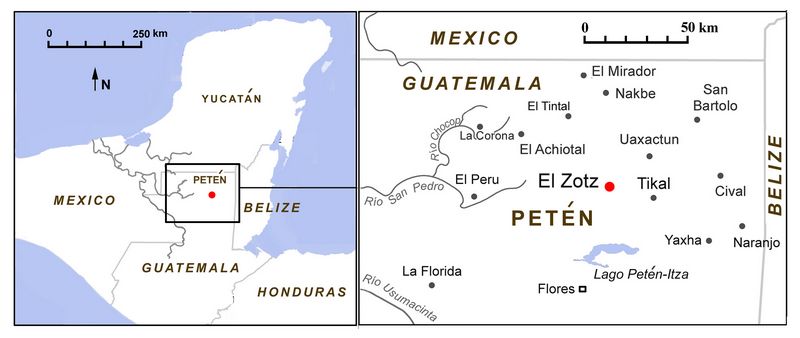 El Zotz in Guatemala
(fig.1) at risk of heavy looting. Preliminary investigations in
2017 and further excavations in 2018 indicated that an eccentric elite
identity developed at La Luna in the period preceding the Maya
Collapse, as an alternative center of prestige outside the epicenter of
El Zotz.
El Zotz in Guatemala
(fig.1) at risk of heavy looting. Preliminary investigations in
2017 and further excavations in 2018 indicated that an eccentric elite
identity developed at La Luna in the period preceding the Maya
Collapse, as an alternative center of prestige outside the epicenter of
El Zotz.Fig.1: Location of El Zotz in the Petén region of northern Guatemala.
The size and design of La Luna are standard for a rustic, commoner’s settlement. It lacks any monumental architecture, art, or inscriptions. However, the dwellings abound in valuable prestige ceramics and other high value items that are unprecedented outside royal courts. This contrast between expectations borne of a century of investigation and the initial results obtained at La Luna led me to investigate differences within the Maya elite for my dissertation (Haviland and Moholy-Nagy 1992).
La Luna was occupied in the Late Classic (550-850 AD), a time of prosperity at
El Zotz before the royal courts of the Central Lowlands collapsed. During the second half of the Late Classic (725–850 AD), substantial changes at El Zotz reflect a renewed royal investment. The El Zotz Acropolis was extensively renovated and expanded, a monumental elite hilltop complex called Las Palmitas was built outside its core, and the external political ties of El Zotz shifted back towards local giant Tikal. It is in this context that a high number of prestige objects, normally only seen in royal courts, were dispersed to La Luna. The rise of La Luna, the extension of the Acropolis, and the creation of Las Palmitas suggests that the aristocracy at El Zotz expanded and diversified at this time, before complete system failure in the Terminal Classic (850-1000 AD). However, the relationship of these different elite communities to one another, and the extent to which they were actually unified or segregated, is unknown.
Understanding such relationships within the aristocracy is critical to identifying the political stressors that can explain the process of collapse. This project identifies the practices of the residents at La Luna and compares them to other elite families around the core of El Zotz. The ways in which these communities parallel or differ from one another will demonstrate how unified the local aristocracy was at El Zotz. By asking what happens between those in power before things fall apart, I hope to demonstrate the conditions within a political organization that preceded decline.
Previous work at the site:
La Luna is a residential group comprised of 20 mounds spaced across three
artificial terraces, approximately 2 km east of the small royal center of El Zotz (fig.2).
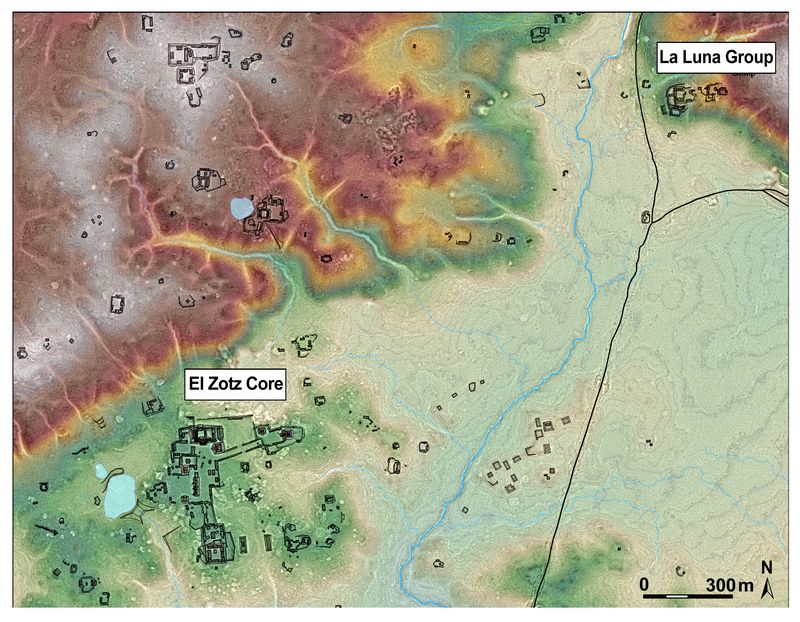 Omar Alcover Firpi of the Proyecto Arqueológico El Zotz (PAEZ)
first identified La Luna during reconnaissance in 2015. In 2017 a
pilot study led by the author cleaned out looter’s trenches in three
structures and placed test pits around the complex’s main patio. The
exceptional quantity and quality of the pottery that was collected from
these excursions prompted the return to the site in 2018 and 2019 for
Omar Alcover Firpi of the Proyecto Arqueológico El Zotz (PAEZ)
first identified La Luna during reconnaissance in 2015. In 2017 a
pilot study led by the author cleaned out looter’s trenches in three
structures and placed test pits around the complex’s main patio. The
exceptional quantity and quality of the pottery that was collected from
these excursions prompted the return to the site in 2018 and 2019 formore thorough investigation.
Fig.2: Map of the center of El Zotz and La Luna (T. Garrison).
Excavations in 2018 focused on clearing and stabilizing looter’s trenches around the group while placing test pits behind structures in search of refuse deposits. These investigations identified two principal structures (T1-11 and T1-3) on the main terrace at La Luna that yielded the most material and information regarding activities at the group. In 2019 structures T1-11 and T1-3 were targeted for extensive excavations of architecture.
Within Maya studies, little is known about the actual internal structure of royal courts and relationships between elites. Despite large scale excavations of royal centers since the 1920s, the misconception that Maya sites served as empty religious centers hindered studies of Maya politics for decades (Ek 2019). Questions of what was an “elite” in these societies, and the nature and function of the Maya court (Chase & Chase 1992; Houston and Inomata 2001a,b) have begun to be answered by epigraphic decipherments and excavations (Jackson 2013, Rossi 2015). However, groupings and interrelationships within the Maya court are still poorly understood. These issues are clouded by vague social distinctions in the archaeological record and insufficient textual references to nonroyal elites.
The Maya elite are a clear case of such a generalized social group in need of
sharper definition. The internal structure that distinguished magnates within the Maya court, and the level of cohesion between them, would have impacted stressors within the political system. Data on this internal structure is critical not just to understanding Maya government and organization, but also to explaining the political events that shaped Maya society, particularly the breakdown of political structures. The collapse is being looked to more frequently as a model for environmentally and socio-politically motivated decline. While archaeologists have established the effect of droughts in the Petén, and political breakdown from internal and external competition to the south, less is known about the political situation that unfolded in the Central Petén at this time (Iannone 2014, Iannone et al. 2016, Demarest 2004). Such information is key not just to clarifying Maya culture history, but also for understanding the general process of societal collapse and determining the political conditions that destabilize social systems.
The 2019 field season at La Luna was dedicated to the first excavations of
architecture at the group, with an aim to uncover each structure’s architectural shape and stratigraphy, while also locating ritual deposits. The team at La Luna opened horizontal exposures and vertical trenches across two structures (T1-11 and T1-3) surrounding the main courtyard at La Luna, which were associated with large ceramic deposits in 2018. This technique opened a large surface area to view the final architectural phase in its totality, and revealed how each building developed over time.
Greater coverage provided by trenches and horizontal units also increased the
probability of encountering caches or burials, and generated a larger sample of material from each phase of construction for dating and analysis. Two samples were collected for AMS 14C dating from each structure for stratigraphic provenience. These results allowed me to anchor the building sequence of each structure in time, and ensured that comparison with other elite residences at El Zotz is between contemporaneous contexts.
Various delays of the 2019 season pushed the original start date of the project from May 8th to June 24th. With the July rainy season looming, PAEZ was forced to scale back its 45-day excavation plan to 27 field days. This allowed for 23 days of excavation and 4 days of backfilling. With a shortened time frame the team at La Luna worked quickly to accomplish as much as possible, and was still able to achieve the major goals of this project.
Goals:
The three main goals of this project were to;
1) Continue to mitigate looting at La Luna
2) Excavate materials to characterize the behavior of the nobility at this group
3) Compare the behavior at La Luna with central El Zotz elite complexes to
determine divisions in the local aristocracy
The first goal involved checking for new illicit excavations around La Luna and mapping the location of current looter’s trenches to keep track of damage. Upon arrival at La Luna upturned soil was identified on the slope south of Str. T2-1, however there was no additional burrowing into structures. This informal pit was most likely dug to probe the area behind Str. T2-1 after it was test pitted in the 2018 season. This is occasionally done by looters after formal excavations have ceased, to see if there is anything of value or interest that was not removed by archaeologists. One week into the field season an abandoned poacher’s camp was found approximately 100 m north of La Luna (fig.3). Near this camp was the body of a butchered and partially decomposed peccary. Based on state of the camp and the decomposition of the peccary, the camp had been used recently, suggesting that the area around La Luna is still frequented by poachers. It is these poachers who are most likely to loot structures opportunistically while out hunting.
While the original plan for mapping looter’s trenches was based on the use of a GPS, this was modified to utilize the project’s lidar data, which is significantly more accurate. Drawings were made of the locations of illicit trenches in each structure at La Luna, and then compared these to looter’s tunnels identified in the 2016 lidar data
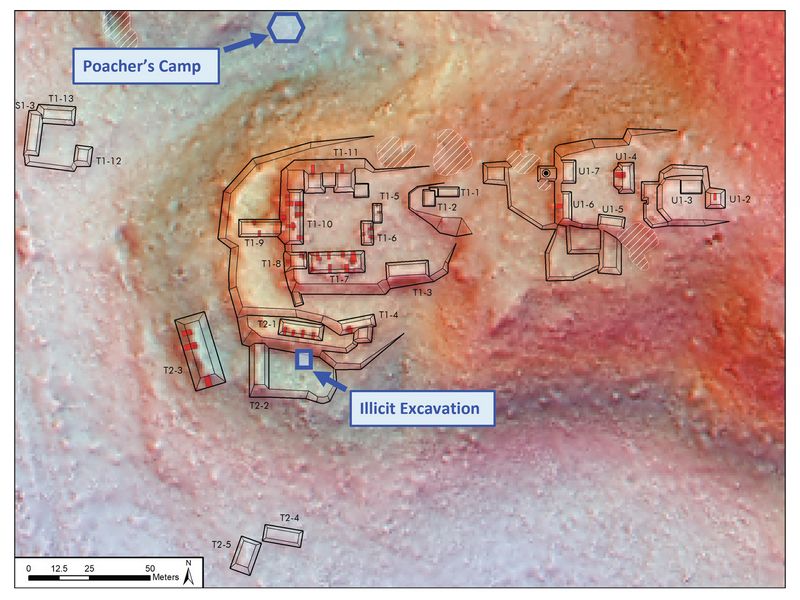 by director Tom Garrison. No new
burrows were noted, indicating that no buildings had been damaged with
new units since 2016, although it is possible that individuals
conducted their own “investigations” in the existing tunnels since that
time. With this current map of looting at La Luna it will be possible
to track illicit activity going forward (fig.3). It is the project’s
hope that after another season of carefully monitored activity at La
Luna fewer poachers and chance looters will be drawn there.
by director Tom Garrison. No new
burrows were noted, indicating that no buildings had been damaged with
new units since 2016, although it is possible that individuals
conducted their own “investigations” in the existing tunnels since that
time. With this current map of looting at La Luna it will be possible
to track illicit activity going forward (fig.3). It is the project’s
hope that after another season of carefully monitored activity at La
Luna fewer poachers and chance looters will be drawn there.Fig.3: Map of looter's trenches at La Luna since 2016 and 2019 illegal activities (T. Garrison – base map and looter’s trenches).
Although it is clear from 2019 that La Luna is still a hotspot for illegal activities, the current record of looter’s trenches suggests that plundering has declined since excavations started at the group, and current illicit activities are kept at a distance, downhill of La Luna rather than at its center.
The second goal of this project was to recover materials that can be used to characterize the behavior of the elites at La Luna. My team excavated significant portions of Structures T1-11 and T1-3 and successfully salvaged a high volume of quotidian, ritual, and exotic objects that reflect the day-to-day practice of the original inhabitants of La Luna. Common artefacts included pottery sherds, stone tools, faunal bones, figurines, and obsidian. The pottery, lithics, and fauna can be used to shed light on stylistic preferences, production practices, and diet respectively, while jointly illustrating overall wealth and domestic practices at the group. Religious activities are indexed by the sacred objects that were collected, including ceremonial vessels and figurines, and by the ritual contexts that were uncovered, namely a burial and a ceramic deposit at Str. T1-11. Furthermore, the interaction and trade networks in which the people at La Luna participated can be deduced from the foreign ceramic styles and exotic raw materials that were found, such as obsidian, greenstone, and marine shell. All together, these objects and contexts revealed by the 2019 excavations provided the necessary data to characterize the elite lifestyle at La Luna in the Late and Terminal Classic.
The third and ultimate goal of this research was to compare the behaviors of the nobility at La Luna to those at other contemporary elite residences around El Zotz. Data from La Luna and from previous excavations at the Acropolis extension and Las Palmitas will be used to determine whether the La Luna magnates behaved as a distinct social unit withn the local nobility, or if there was strong cohesion among the aristocracy – or, alternatively, if a different combination of divisions existed. Using Sam Lucy’s theory of identity through shared behaviors, where individuals with common social practices share an identity based on these practices, this data will be used to detect subsets among the El Zotz elite based on the behaviors they have or lack in common (Lucy 2005, Bourdieu 1990).
Methods and Findings: Excavations
During the 2019 field season structures T1-11 and T1-3 were excavated using a
mixture of horizontal and vertical excavations units, which exposed the final phase of each mound, while revealing the complete stratigraphy of the structures in various units (fig.4). Excavations were planned along a 2x2 m grid following the orientation of each structure. Significant tree growth on the two mounds dictated that excavations were isolated to the eastern half of both structures. Investigations targeted the central axis and east corners of both buildings. A total of 20 units were excavated, most of which were 2x2 m in size, with a few ranging from 1x2 to 1x1 m. This work was carried out by 7 excavators.
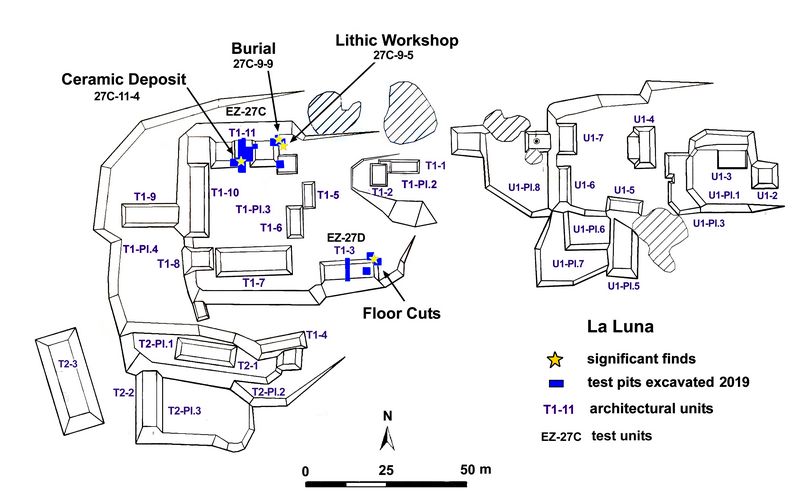
Fig.4: Map of 2019 excavations at La Luna. Blue rectangles represent excavation units, stars denote significant features (Base map – T. Garrison).
Excavations were recorded using standardized PAEZ lot forms, and illustrations of all units were drawn by hand in the field and subsequently digitized. In addition to these standard forms of recording, stratigraphic profiles and excavation plan views were photographed to create three-dimensional models using photogrammetry.
EZ-27C (Structure T1-11): This house mound on the main terrace adjoins with structure T1-10 and frames the north end of the central patio at La Luna. Excavations in 2018 cleared out the structure’s two looter’s trenches, revealing that the mound was built over a pre-existing chultun. This bedrock chamber was decommissioned and packed with a ritual deposit in approximately the late seventh century AD before it was sealed, indicating the structure itself was likely built in the late seventh or early eighth century.
Fifteen excavation units across Str. T1-11 found that it was composed of roughly cut limestone blocks and thin stucco floors that quickly degraded, leaving only patches of the surfaces that once existed. Poor preservation made it difficult to distinguish between construction events at Str. T1-11, but a unit on the northeast corner of the structure yielded some partial floors for clarification. A thin floor just above bedrock at this corner represents the first phase of Str. T1-11, which may have been contemporary with the aforementioned chultun as an adjacent activity area. This floor was followed by a layer of dense fill radiocarbon dated to 652-768 AD (95.4% probability), consistent with when the chultun below Str. T1-11 was decommissioned. A second, thicker floor above this fill delineates the beginning of a basal platform. At this corner, the base supports two ascending tiers, however in the middle these do not appear.
The bimodal shape of this structure on the surface, and the vertical units along the building’s central axis and northeast corner, demonstrate that the final iteration of the structure was divided into two distinct upper platforms on the east and west ends of the mound, with an open section in the middle linked by the basal platform. This is unique, as the rest of thebuildings at La Luna are generally level in height. Unfortunately, it was not possible to determine if the multi-tiered platform was constructed all in one event, or if the different sides and tiers were added at later dates. At the very least, this sequence demonstrates that a floor surface was laid over bedrock, followed by a major construction event in the late seventh or early eighth century, while ceramics show further continuity into the Terminal Classic.
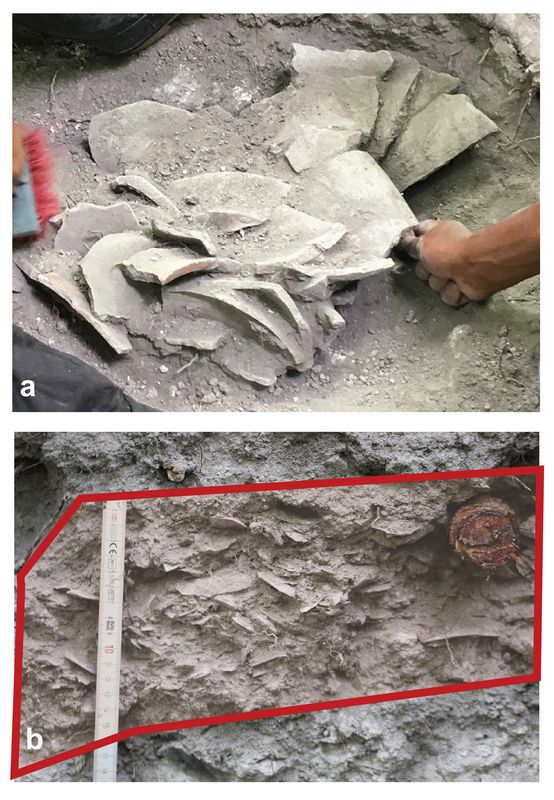
Multiple noteworthy features were uncovered at Str. T1-11. A Terminal Classic ritual deposit, comprised of monochrome serving vessels smashed on top of each other, was found directly in front of the mound’s south retaining wall along its north-south axis (EZ-27C-11-4; fig.5a). Though only approximately 0.5 m in diameter and 0.1 m deep, the offering contained almost 400 large sherds from red, orange, brown, and black jars, bowls, and plates. Given the Terminal Classic characteristics of these vessels and the fact that they were deposited directly in front of the building only 20 cm below the surface, it is possible that this concentration of sherds reflects a termination deposit marking the end of this house mound’s lifecycle.
Fig.5a (top): Ritual ceramic deposit found in Str.T1-11 (A. Bishop).
Fig.5b (bottom): Lithic debitage layer from EZ-27C-9-5 (A. Bishop)
At the northeast corner of Str. T1-11 a lithic production area was located (EZ-27C-9-5, fig.5b). Found at approximately the level of the mound’s basal platform, this workshop locus yielded over 18 kg of debitage that appeared to be primarily chert flakes. Additionally, other unique objects such as a broken hand axe and flecks of abalone indicate a potential multitude of cra
 ft production in this one location. This discovery was particularly
unique as it is the only lithic workshop found at El Zotz.
ft production in this one location. This discovery was particularly
unique as it is the only lithic workshop found at El Zotz.Underneath this production refuse, in the same unit, the burial of a small child was discovered (Burial 38, EZ-27C-9-9, fig.6). The individual was placed in a flexed position on his/her right side, with his/her head facing north. The burial was located in building fill below the basal platform of Str. T1-11, making it difficult to glean much information from the context of the remains.
Fig.6: Burial 38, EZ-27C-9-9 (A. Bishop & E. Román).
No artefacts were placed directly next to the individual, however two carefully crafted whistles (fig.7) and a grinding stone were found in the fill immediately above the burial, which may have been offerings meant to accompany the interred. Based on his/her size the individual appears to be about 3-4 years in age, and radiocarbon dates indicate the burial took place between 652-722 AD (72.9% probability). Notably, this is the only non-adult burial found at La Luna, and the only corner burial. This novelty is even more intriguing when considering that all other examples of infant and toddler burials at El Zotz were interred as offerings. While only some are clea
 rly sacrificed, there is a
definitive use of infant and toddler remains in dedicatory caches at El
Zotz and its neighboring sites (Scherer 2018). Furthermore, corners are
a common location for ritual offerings in Maya structures. The young
age and unusual placement suggest that Burial 38 may not have been a
routine household interment, but possibly a sacred offering in the construction of Str. T1-11.
rly sacrificed, there is a
definitive use of infant and toddler remains in dedicatory caches at El
Zotz and its neighboring sites (Scherer 2018). Furthermore, corners are
a common location for ritual offerings in Maya structures. The young
age and unusual placement suggest that Burial 38 may not have been a
routine household interment, but possibly a sacred offering in the construction of Str. T1-11.Fig.7: Whistles associated with Burial 38.
EZ-27D (Structure T1-3): This house mound borders the south edge of the main terrace, approximately 10m east of the central patio. As one of the only un-looted structures at La Luna, the context of the building was still preserved. Five excavation units revealed earlier phases of muddled building fill, similar to what was found at Str. T1-11, but a well-defined final phase in the northeast corner. Profiles of this structure showed dense layers of building fill with carbon from 656-727 AD (68% probability). Above this fill sits a thick stucco floor, followed by additional layers of building fill until topsoil is reached. These two building phases may have also been separated by revisions and resurfaced floors of poor quality that did not preserve in the stratigraphic sequence.
Horizontal excavations of the northeast corner of Str. T1-3 revealed the most clearly defined architecture at La Luna; a single tier platform with well-preserved retaining walls and an intact floor in front. Carbon on top of this floor dated to 764-891 AD (84% probability), while ceramics confirmed that this structure was in use into the Terminal Classic. Notably, wall stones from this final phase were cut from the floor and removed at some point after their original placement. The reuse of architectural stones is a trend across lowland Maya sites in the Terminal Classic, thus this transformation process is consistent with a Terminal Classic occupation at La Luna.
3-D documentation – Photogrammetry:
Architectural profiles were documented using photogrammetry equipment. The goal of this was to create 3-D models of the profiles and architectural features uncovered during excavations, which would make it easier to reexamine excavated contexts, and aid in the dissemination of results to public and academic communities. The east profile of the north-south trench that bisected Str. T1-11 was photographed using a Canon Rebel EOS 6 camera at the end of the season. A total of 630 photos were taken of the 16 m profile from different distances and angles. Additionally, a DJI Mavic Pro drone was loaned by another PAEZ archaeologist to capture aerial photos for plan views of the excavations at Structures T1-11 and T1-3. This device shot a total of 627 photos.
Methods and Findings: Lab Work
The materials that were excavated with funds from the current project are currently under analysis. Thus far, I have completed a type-variety-mode classification of the ceramics, photographed and started iconographic analysis of decorated pottery, taken readings of all suitable obsidian shards using a portable X-ray Florescence instrument (pXRF), and received the results of the radiocarbon dating. In total, 5,911 ceramic sherds (weighing 141 kgs.) were excavated and analyzed from La Luna. Moreover, materials undergoing analysis by project experts include 31.3 kg of lithic objects, 60 bone fragments, 73 pieces of obsidian, 18 shell fragments, and 9 clay figurines. These materials are housed in the PAEZ lab, located in San Lucas, Guatemala.
Type-Variety-Mode:
Structure T1-11 yielded 3.12 kg of ceramic material, while 1.22 kg of pottery was recovered from Str. T1-3. Ceramics from both operations came almost entirely from building fill, and thus represent a reuse of household refuse, accumulated over a long span of time, and mixed together in one context. These ceramics were sorted using a combination of type-variety and modal techniques. Type-variety-mode classification is a standard form of Maya ceramic analysis (Sabloff 1975) that enables distinctions between time periods and regions. It focuses on surface decoration (slip, incisions, impressions), and elements known as modes that note shape, width, function, and vessel features (e.g., spouts and feet). This allows ceramicists to date contexts based on the age of pottery from each context.
Furthermore, through decoration and modes one can deduce the range of wealth
and daily activities carried out at La Luna by distinguishing between different categories of vessel function: (1) utilitarian containers used for storage or cooking, (2) monochrome pottery used for serving food, and (3) prestige polychrome and fine paste vessels used for special occasions. Finally, by sorting types and varieties, one can distinguish between pottery of different influences or origins. The form of impressions on a vessel can indicate whether a potter was inspired by traditions from Tikal versus the Snake Kingdom (Forné 2012), while painting styles can be traced back to distinct workshops (Reents-Budet et al. 2010).
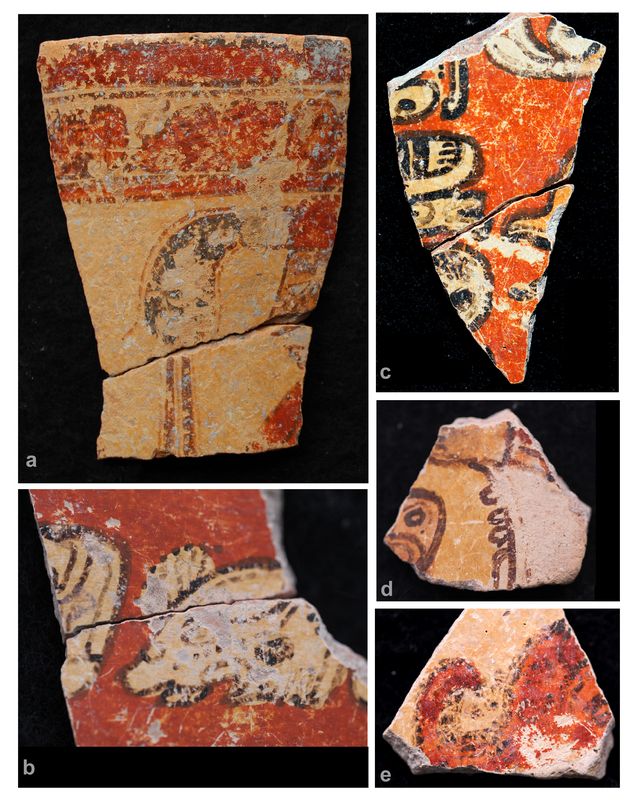
Ceramic types correspond to different chronological phases. Both structures at La Luna yielded ceramics from phases Tepeu 1 (550-700 AD), Tepeu 2 (700-850 AD), and Tepeu 3 (850-900 AD), with a few examples of Postclassic material (900-1300 AD). Iconography painted on polychromes largely corresponded to these time periods as well, following Robert Smith’s design typology (Smith 1955). The dating of these ceramics is consistent with materials excavated in 2018, and corroborates that La Luna
was inhabited when El Zotz reached its height in the Late Classic, and when it declined in the Terminal Classic, with some fleeting activity in the Postclassic.
Fig.8: Samples of Polychrome pottery: a) sherd depicting death god A Prime with an inscription above detailing a section of the Primary Standard Sequence. b) Section of Primary Standard Sequence inscription around vase rim. c) Text identifying wahy figure as the “Fire-tailed Coati” (Kahk’ Ne Tz’uutz’). d) Hand of figure. e) Partial glyph. (A. Bishop).
Both mounds had similar proportions of vessel function types. Of the pottery sherds recovered from Structure T1-11, 59.4% were unslipped, utilitarian types composed of mainly jars, 27.9% were slipped monochrome serving vessels, comprised of mostly jars and open bowls, and 12.8% were polychrome and fine paste prestige vessels, typically in the form of bowls and plates. Ceramic material from Str. T1-3 was comprised of 56.7% utilitarian containers, 27.9% monochrome serving vessels, and 15.5% prestige vessels, each with similar form associations to those from Str. T1-11.
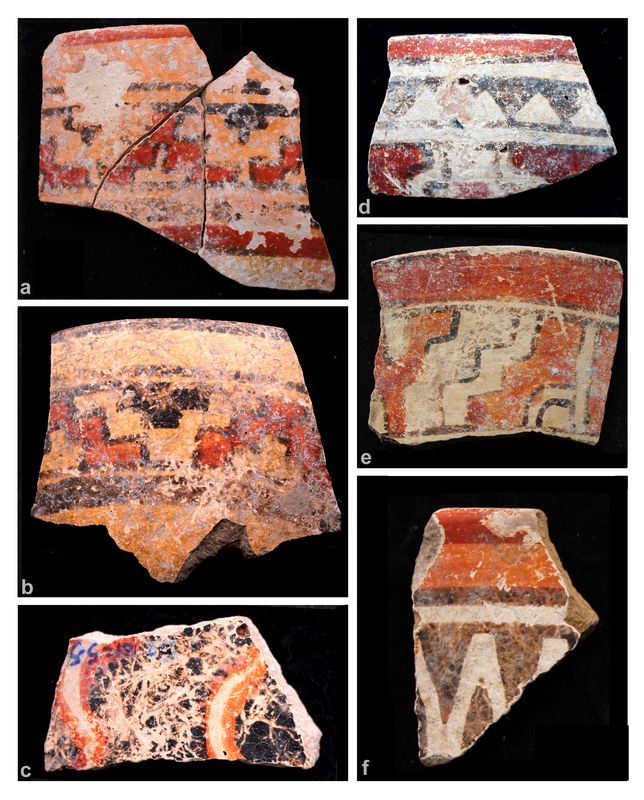 The dominance of utilitarian and monochrome vessels
over prestige ones is consistent with the assemblage of a typical Maya
household, however, in general the percentage of high-value, ceremonial
pottery at both structures is higher than usual for El Zotz (see
figs.8-9 for examples). For comparison, the ceramic assemblage from Las
Palmitas contains only 4.1% prestige wares, and the Acropolis extension
only 1.5%. In fact, the only contemporaneous residential assemblage
that approaches the proportion of ceremonial vessels at La Luna is from the Acropolis itself, which contains 10% prestige pottery.
The dominance of utilitarian and monochrome vessels
over prestige ones is consistent with the assemblage of a typical Maya
household, however, in general the percentage of high-value, ceremonial
pottery at both structures is higher than usual for El Zotz (see
figs.8-9 for examples). For comparison, the ceramic assemblage from Las
Palmitas contains only 4.1% prestige wares, and the Acropolis extension
only 1.5%. In fact, the only contemporaneous residential assemblage
that approaches the proportion of ceremonial vessels at La Luna is from the Acropolis itself, which contains 10% prestige pottery.Fig.9: Samples of Polychrome pottery. a-f: Geometric designs (A. Bishop).
Examples of imported pottery were found in small quantities, and only at Str. T1-11. The most common non-local type was the Honey Yellow variety, a high-gloss, high quality orange polychrome that is believed to have been produced at El Perú-Waka’ (Eppich, pers. com., July 28, 2018). A few fragments were identified as Altar Naranja, an orange fine ware from the Usumacinta region, and one sherd was classified as Petkanche, a black-background polychrome style that originated in the northwestern Belize/southeastern Quintana Roo (Ball 1977). These varieties, which were also present in the 2018 assemblage from La Luna, strengthen claims that the residents of La Luna had access to exchange networks with large, nearby dynasties such as El Perú-Waka’ and distant courts to the northeast and southwest.
Iconography:
Sherds with painted and incised iconography from the 2019 season were photographed in the lab using a Nikon D3000 DSLR camera. The types of imagery depicted on sherds were recorded in a spreadsheet using descriptions and terms from the original Uaxactun ceramic typology (Smith 1955). Similar iconographic information is also being recorded from a sample of ceramics from the Acropolis extension and Las Palmitas. This data can then be used to compare the ceremonial imagery that was preferred at each of these three elite complexes. The results will speak to the identity of the families at La Luna and how this aligns with the other nobility at El Zotz.
Obsidian Sourcing:
Obsidian shards of minimum dimensions (1 x 1 x 0.2 cm) from La Luna, the Acropolis extension, and Las Palmitas, were analyzed with a Tracer 5i pXRF instrument loaned by the University of Southern California. This device records the elemental composition of each piece of obsidian, which can then be matched to the geochemical signature of known volcanic sources, or grouped with pieces of similar composition to identify groups of objects from the same source. A total of 148 fragments of obsidian (48 of which came from La Luna) were washed and analyzed for a length of 60 seconds each. The calibration of the pXRF was checked using a Bruker obsidian standard at the beginning and end of every session, and after every 20 recordings.
Compositional analysis with pXRF is a common technique for sourcing artifacts and has been used to track both local and inter-regional trade networks at El Zotz, across the Maya region, and beyond Mesoamerica (Hruby 2018; Moholy-Nagy et al. 2013; Glascock 2011). Therefore, such methods are reliable for identifying material sources and for tracking the interaction networks utilized by the respective elite communities at La Luna, the Acropolis extension, and Las Palmitas. The next step in this study is to run the compositional data through postprocessing and then compare the results of each obsidian object with volcanic sources to determine their point of origin. Basic statistics will then be used to compare which sources were favored by each elite complex, and how diverse or uniform each complex was in their acquisition sources.
Lithics, Fauna, and Shell:
Project specialists were originally slated to examine the lithic, faunal, and malacological remains excavated at La Luna in the 2019 lab season. Each of these materials reveals distinct information about the practices at La Luna and how these compare to other elites. Lithics represent stone tool acquisition and production, while fauna and shell reflect diet and access to coastal trade networks. Unfortunately, due to the permit delays a complete field season could not be executed in 2019. For this reason, most excavations at El Zotz were postponed, and material specialists were rescheduled to examine the site’s assemblages in the summer of 2020 instead. Due to the sudden outbreak of COVID-19, it is now uncertain when these analyses will be completed.
Key Artifacts:
Over the course of the 2019 investigations a number of unique artefacts were uncovered. The most prominent of these were the polychrome sherds that dominated
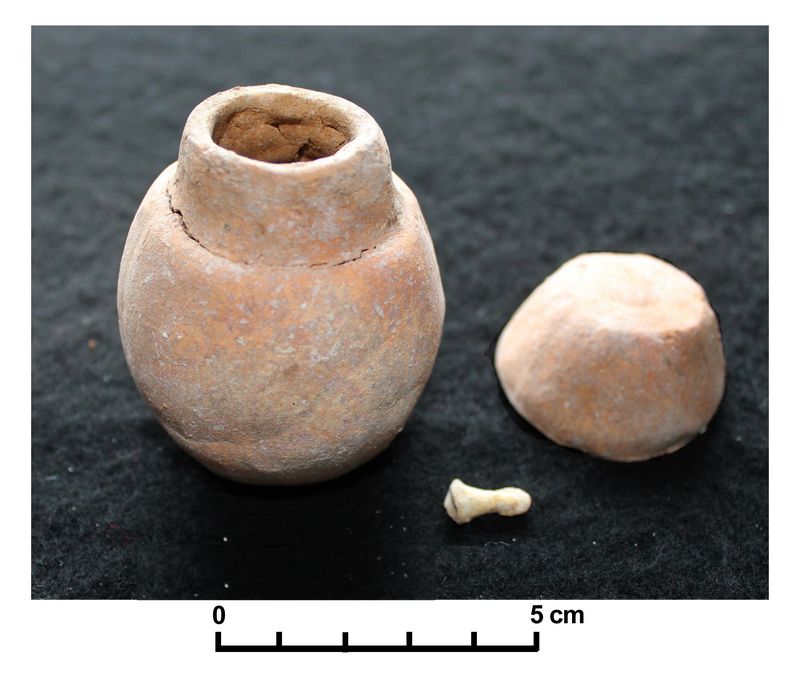 the
ceramic assemblage, as was the case in 2018. These fragments were
painted with a range of designs from simple lines, to geometric
patterns, to figural images of impressive artistry
(figs.8-9). Another unique ceramic object, excavated at Str. T1-11, was
an unslipped miniature jar containing a single finger bone (fig.10).
Unfortunately, this jar was found in loose fill, so although it seems
to have some sort of ritual association, it was not possible to glean more from its context.
the
ceramic assemblage, as was the case in 2018. These fragments were
painted with a range of designs from simple lines, to geometric
patterns, to figural images of impressive artistry
(figs.8-9). Another unique ceramic object, excavated at Str. T1-11, was
an unslipped miniature jar containing a single finger bone (fig.10).
Unfortunately, this jar was found in loose fill, so although it seems
to have some sort of ritual association, it was not possible to glean more from its context.Fig.10: Special find - Miniature vessel with Phalanx (E. Marroquín).
Beyond pottery, two anthropomorphic partial whistles, uncovered in the same building fill as Burial 38, were notable. One of these was in the form of a kneeling woman wearing a huipil and pendant, and the other in the form of a man wearing a loin cloth and wrap, the texture of which can be seen in a grid-like pattern etched into the clay (fig 7).
In terms of exotic items, one semi-complete marine shell was found at Str. T1-11
in addition to various fragments of mother of pearl and one possible piece of dried coral. These suggest local access to trade networks that extended to the Caribbean coast. Furthermore, one greenstone bead and a small greenstone axe were also uncovered at Str. T1-11, which could have been imported from a number of sources outside the Peten.
Radiocarbon Dating:
Four samples of charred material from La Luna were sent to Beta Analytic, Inc. for radiocarbon dating. Two samples were analyzed from each structure, with the aim to recover a date from the earliest and latest contexts possible at each to define their ranges of occupation (table 1).

Table 1: Radiocarbon dates from sealed contexts at La Luna.
The earliest sample from Str. T1-11 was taken from Burial 38 (EZ-27C-9-9), in the layer of dense building fill beneath the mound’s basal platform. This fill dated to 652-768 AD (95.4% probability), while carbon recovered in loose fill above a thin floor near the surface (EZ-27C-6-3) dated to 1222-1286 AD (95.4%). This very late, Postclassic date is likely the result of ephemeral activity by roaming populations around El Zotz in the Early Postclassic (1000-1300 AD), rather than an indication of late permanent settlement, given the low quantity of Postclassic ceramics at La Luna. Rather, this date corroborates sparse post-dynastic activity signaled by the infrequent Postclassic sherds that have been found near the surface at this group.
Samples from Structure T1-3 were taken from the bottom-most dense layer of fill
beneath the structure (EZ-27D-12-6), and from the floor of the mound’s final preserved phase (EZ-27D-13-2). This early construction fill was dated to 656-769 AD (95.4% probability), which aligns closely with the building fill that was put down for the construction of the basal platform at Str. T1-11, suggesting that the two structures were erected around the same time. Carbon from the final iteration of Str. T1-3 dated to 764-891 AD (84%). This time frame, along with the range of Tepeu 3 pottery found at this operation, indicates an occupation well into the Terminal Classic. At both structures the radiocarbon samples combined with ceramics demonstrated major construction phases in the late seventh century AD, followed by a continuous occupation into the Terminal Classic, likely ending sometime in the ninth century. Postabandonment activity continued occasionally in the Postclassic, indicating a continued interest in the settlement space even after it was deserted.
Conclusions
Overall the goals for this field season were achieved despite unexpected time constraints. Structures T1-11 and T1-3 were thoroughly excavated to bedrock in vertical units, and extant architecture was exposed to reveal the bones of each building. In this regard, the architecture was poorly preserved and only certain structural features remained, however, sufficient stucco and stonework survived to make estimates about the general shape of each mound. Structure T1-11 had the most unique architecture encountered at La Luna, with its two separated upper platforms connected by a basal platform. In contrast, T1-3 was a good example of the basic architecture at La Luna, with its standard rectangular shape and single low platform. Thus, these excavations demonstrated the range of buildings that were erected and inhabited by the people at La Luna.
Compared with the architecture at La Luna, the cultural deposits that were uncovered over the course of excavations were pristine. Archaeologists identified a cache of smashed ceramics in situ, directly in front of Str. T1-11, suggestive of a termination ritual. This deposit indicates that Str. T1-11 held some significance to the residents living at La Luna, unsurprising given its central location at the group’s main patio, and its unique, dualistic architecture compared to the simple mounds that frame the rest of this patio.
The first lithic production area ever found at El Zotz was also identified off the back of Str. T1-11, revealing a complete stratigraphic layer of debitage that can speak to stone tool production at El Zotz. Although it is certain that stone tool manufacture was common across El Zotz during its occupation, as these objects were essential to daily life, excavations around El Zotz have not revealed extensive lithic production off of residential structures or any other buildings. This may signal that a greater focus was placed on craft production at La Luna than at other residential complexes, and suggests that the activity was performed more publicly – at the central patio off the back of one of the main structures – than was common in other groups.
Beneath this deposit the team at La Luna uncovered the interment of a small child, Burial 38, in building fill. This was the first intact burial excavated at La Luna, and the first non-adult. The young age and corner placement of the remains have ritualistic associations, given that corners are often a location for offerings in Maya architecture, and that deceased babies are only found in dedicatory caches at El Zotz. The scrambled context of the body, in dense architectural fill with only a few loosely associated artefacts, makes it hard to confirm the intent of this burial. However, the age and context are undeniably suggestive, and prompt conjecture as to whether this individual was interred as a dedication to the construction of Str. T1-11. Such a sacred act would echo the ritual decommissioning of the chultun below Str. T1-11, which was done not long before the mound’s construction.
All of these deposits suggest that Str. T1-11 was unique and culturally significant at La Luna. It housed activities not typically performed on main residential structures at El Zotz, like lithic production, and was possibly founded, but definitively sealed, with sacred rites that manifested in physical offerings. When combined with the findings in 2018, which revealed a ritual cache in the chultun beneath Str. T1-11, and preserved polychrome ceramics in fill suggestive of a primary deposit of ceremonial vessels, there is little question that this building was ritually charged. All things considered; it is probable that Str. T1-11 served a religious function for the residents of La Luna.
The artefacts found this season were in alignment with interpretations from 2018,
suggesting that the people at La Luna were unconventional elites that did not present
their status in all of the typical ways. Though the architecture excavated in 2019 was
undoubtedly modest, the prestige ceramics at the group continue to trump those found
anywhere else at El Zotz in quality and quantity. Imported pottery and other goods are consistent with those uncovered in 2018, corroborating interaction with El Perú-Waka’, the Usumacinta region, northwestern Belize/southeastern Quintana Ro, and the Caribbean coast. Additional analyses of the assemblage are still ongoing.
Ongoing Plans
Going forward I will continue with the lab analyses outlined above and attempt to
complete as much as possible remotely during the COVID-19 outbreak. My next step
will then be to compare my findings with the already acquired data from the Acropolis
extension and Las Palmitas. This comparison will reveal the range of behaviors within a Maya aristocracy, and the different elite identities that coexisted within a small court. The 2019 excavations provided a much clearer picture of life at La Luna. Work this season confirmed a significant Terminal Classic occupation at the group, uncovered the first and only in-situ burial there, and revealed the generally poor architecture at La Luna. Additionally, the lithic workshop found off the northeast corner of Str. T1-11 will be excavated further in the 2021 field season to recover the entirety of this production area.
The complete findings from the 2019 season are published in the PAEZ annual
report, which was submitted to the Guatemalan government and posted online at
Mesoweb.com in January 2020. This includes my report on the excavations at La Luna as well as my report of the ceramics from the group. Preliminary findings were
discussed in a paper at the national Guatemalan archaeology conference (Simposio de
Investigaciones Arqueológicas en Guatemala) and will be presented in a paper at the
next annual meeting of the Society for American Archaeology.
A complete interpretation of the results from this project is published in my dissertation, currently available here.
References:
Ball, Joseph W. 1977 The archaeological ceramics of Becan, Campeche, Mexico.
Middle American Research Institute, Tulane University, New Orleans.
Bourdieu, Pierre. 1990 The Logic of Practice. Stanford University Press, Stanford, CA.
Chase, Diane Z., and Arlen F. (Arlen Frank) Chase 1992 Mesoamerican elites: an
archaeological assessment. University of Oklahoma Press.
Demarest, Arthur. 2004 After the Maelstrom: Collapse of the Classic Maya Kingdoms
the Terminal Classic in the Western Peten. In The Terminal Classic in The Maya
Lowlands: Collapse, Transition, And Transformation, edited by Arthur A. Demarest,
Prudence M. Rice, and Don S. Rice. University Press of Colorado, Boulder, CO.
Ek, Jerald. 2019 The Inertia of Old Ideas: A historical overview of theoretical and
methodological challenges in the study of Classic Maya political organization. Journal of Archaeological Research: July 2019.
Forné, Melanie. 2012 The very Late Classic Maya: ceramic research for the definition of an interregional level of economic interaction. In Annual Meeting of the Society for American Archaeologists. Memphis, TN.
Garrison, Thomas G., Stephen Houston, and Omar Alcover Firpi. 2019 Recentering the rural: Lidar and articulated landscapes among the Maya. Journal of Anthropological Archaeology 53: 133–146.
Glascock, Michael. 2011 Comparison and Contrast Between XRF and NAA: Used for
Characterization of Obsidian Sources in Central Mexico. In X-Ray Fluorescence
Spectrometry in Geoarchaeology, edited by M. Steven Shackley. Springer Press.
Haviland, William, and Hattula Moholy-Nagy. 1992 Distinguishing the High and Mighty from the Hoi Polloi at Tikal, Guatemala. In Mesoamerican Elites: An archaeological assessment, edited by Diane Chase and Arlen Chase.
Houston, Stephen D., and Takeshi Inomata. 2009 The Classic Maya. Cambridge
University Press.
Houston, Stephen D., and Takeshi Inomata. 2001a Royal courts of the ancient Maya.
Volume Two, Data and case studies. Westview Press, Boulder, CO.
Houston, Stephen D., and Takeshi Inomata. 2001b Royal courts of the ancient Maya.
Volume One, Theory, comparison and synthesis. Westview Press, Boulder.
Hruby, Zach. 2018 Lithic Technologies and Economies at El Zotz. In An Inconstant
Landscape: The Maya Kingdom of El Zotz, Guatemala, edited by Thomas G. Garrison and Stephen Houston, pp. 93–115. University Press of Colorado, Louisville.
Iannone, Gyles. 2014 The great Maya droughts in cultural context: case studies in
resilience and vulnerability. University Press of Colorado, Boulder.
Iannone, Gyles, Brett A. Houk, and Sonja A. Schwake. 2016 Ritual, violence, and the
fall of the classic Maya kings. University Press of Florida, Gainesville.
Jackson, Sarah E. 2013 Politics of the Maya court: hierarchy and change in the late
classic period. University of Oklahoma Press, Norman.
Lucy, Sam. 2005 Ethnicity and Cultural Identity. In The Archaeology of Identity:
approaches to gender, age, status, ethnicity and religion, edited by Margarita Díaz-
Andreu García, pp. 171. Routledge, London; New York.
Moholy-Nagy, H., Meierhoff, J., Golitko, M., & Kestle, C. 2013. An Analysis of pXRF Obsidian Source Attributionos from Tikal, Guatemala. Latin
American Antiquity, 24(1), 72-97.
Reents-Budet, Dorie, Sylviane Boucher Le Landais, Yoly Palomo Carrillo, M. James
Blackman, and Ronald L. Bishop. 2010 Codex-Style Ceramics: new data concerning
patterns of production and distribution by. XXIV Simposio de Investigaciones
Arqueológicas en Guatemala. 2010.
Rossi, Franco D., William A. Saturno, and Heather Hurst 2015 Maya Codex Book
Production and the Politics of Expertise: Archaeology of a Classic Period Household at Xultun, Guatemala. American Anthropologist 117(1): 116–132.
Sabloff, Jeremy. 1975 Excavations at Seibal, Department of Peten, Guatemala. Vol. 2: Ceramics. Peabody Museum of Archaeology and Ethnology, Harvard University,
Cambridge Mass.
Scherer, Andrew. 2018 Grave Matters. In An Inconstant Landscape: The Maya
Kingdom of El Zotz, Guatemala, edited by Thomas G. Garrison and Stephen Houston,
pp. 93–115. University Press of Colorado, Louisville.
Smith, Robert. 1955 Ceramic sequence at Uaxactun, Guatemala. Middle American
Research Institute, New Orleans.
Recent Foundation grants: general Archaeology Grants Program w/map
Copyright © 2022 Rust Family Foundation